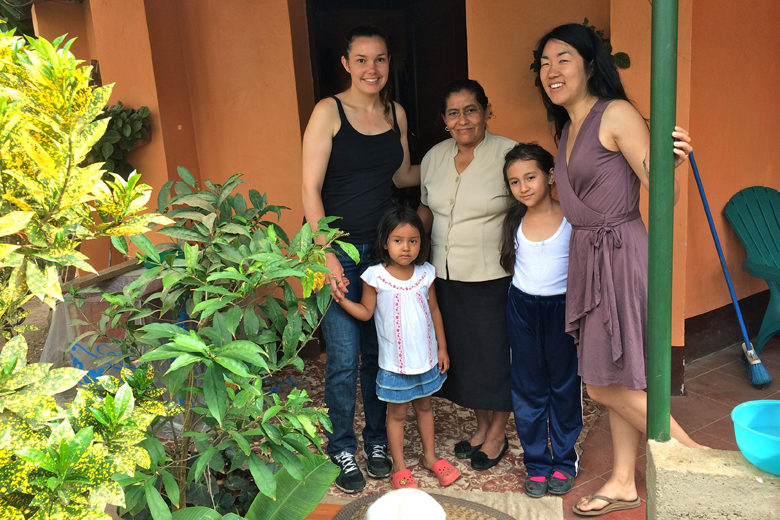
Maria Antonia led me out to her back yard. The air was thick with humidity, and I cherished each breeze under the hot Nicaraguan sun. The metal crown on Maria Antonia’s front tooth glinted as she smiled, proudly gesturing toward the garden she had started on her modest plot of land. She had planted cilantro, onion, bell pepper and a variety of other vegetables now flourishing in old pots and rubber tires. She pointed out the mango, avocado, papaya and nancite trees scattered across the yard, whose fruit she prepared into juices, side dishes or salads. Despite living in rural, impoverished Sabana Grande, where access to fresh fruits and vegetables is limited, Maria Antonia provides her family with a balanced, whole food-based diet. She prioritizes healthy living, a decision likely influenced by the ongoing presence of foreign health professionals, who worked with the local Brigadistas, or native health educators.
I had this exchange with Maria Antonia during a month I spent in Nicaragua as a California State University Sacramento dietetic intern, including a week in Sabana Grande. Working out of small, one-room clinics, I collaborated with a group of UC Davis medical students to provide healthcare and nutrition education. Maria Antonia and her two granddaughters were my host family. Most homes in the village had no running water and many lacked electricity. Despite the poverty, I was surprised to find the daily meals Maria Antonia prepared included meat, various fruits and sometimes even a side of vegetables. In contrast, the other host homes primarily served Gallo Pinto, the mainstay Nicaraguan dish that includes the two staple foods of the country — rice and beans. The ingredients for Gallo Pinto were both readily available and inexpensive. Why was there a discrepancy between the variety of foods my host mother served and the basic Gallo Pinto meal my fellow students received and upon which the majority of Nicaraguans heavily relied? Not only was I receiving a more balanced diet than the other students and villagers, but Maria Antonia and her granddaughters were as well.
I mentioned to Maria Antonia my observation that many of the other families weren’t eating the variety of food that she cooked for her family. She felt that many families chose to spend their money on non-essentials, while she chose to spend her money providing better food for herself and her family. She was also the only local in the village to have purchased a refrigerator, which she is paying off in small payments. She valued having a refrigerator to keep foods safe for her family.
Maria Antonia learned about the importance of growing her own food from Grupo Fenix, a non-profit group that  established itself in the community about 15 years ago. Susan, an American who oversees the work of the non-profit and lives in the village, organizes groups of mostly American students to come to Nicaragua as part of edu-tourism (education combined with tourism). Past students have encouraged locals to grow their own fruits and vegetables. To set an example, Susan started a small farm on her property to teach residents about farming, growing their own crops and ultimately how to use their harvests as a source of healthy foods. Maria Antonia acquired the knowledge and skills to establish her own garden, empowering her to prioritize her family’s health through both her actions and meals.
established itself in the community about 15 years ago. Susan, an American who oversees the work of the non-profit and lives in the village, organizes groups of mostly American students to come to Nicaragua as part of edu-tourism (education combined with tourism). Past students have encouraged locals to grow their own fruits and vegetables. To set an example, Susan started a small farm on her property to teach residents about farming, growing their own crops and ultimately how to use their harvests as a source of healthy foods. Maria Antonia acquired the knowledge and skills to establish her own garden, empowering her to prioritize her family’s health through both her actions and meals.
As a dietetic intern, I have worked with a variety of community-based organizations in the Greater Sacramento area, counseling clients on healthy eating and food preparation, and encouraging them to eat a colorful plate with a variety of fruits and vegetables. However, food access is a growing concern in the United States and hinders many particularly low-income residents from eating enough fresh fruits and vegetables. According to the USDA, 23.5 million Americans live in a food desert. That is more than three times the population of Nicaragua. Despite living in a developed nation, we share food access issues with many developing countries.
My Nicaraguan experience taught me the importance of hands-on nutrition education and local community collaboration. In the United States, we have begun to realize the importance of individual gardens to teach people to sustainably grow their own food while encouraging balanced, plant-based diets. As individual, community, and school gardens increase in popularity, dietitians will have more outdoor classrooms to provide nutrition education and workshops, allowing us to become leaders in the fight against food insecurity. My aim is to make a sustainable health impact in communities with low food access both in my own community and abroad, so people like Maria Antonia can make a difference for themselves and their families.
